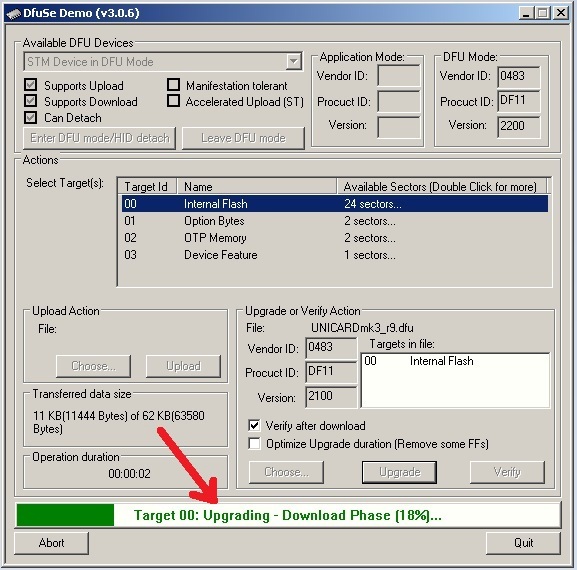Some newer boards with full USB support must be flashed in USB DFU mode. This is a straightforward process in Configurator versions 0.67 and newer. The standard flashing procedure should work successfully with the caveat of some platform specific problems as noted below. The “No reboot sequence” checkbox has no effect as the device will automatically be detected when already in bootloader mode (a DFU device will appear in the connect dropdown if this is the case). The Full chip erase checkbox operates as normal. The baudrate checkbox is ignored as it has no relevance to USB.
- Stm32 Dfu Driver For Mac Download
- Stm32 Dfu Driver For Macbook Pro
- Stm32 Dfu Driver For Mac Free
- Stm32 Dfu Driver For Mac
- Invoking DFU Externally. Sometimes you’re dealing with a larger and more complex system where the STM32 is not the primary processor, you want to prevent accidentally forcing the device into DFU mode by physically requiring the user to augment the device, or you’re simply running low on code space and need to offload it elsewhere.
- You could try doing what I suggested in the other thread, goto the device, select update driver, browse to the Arduino hardware STM32 drivers win maple-dfu folder and select it. The info files for Maple DFU are in there, and it may load them.
Description Compatible with the x86 and x64 platforms The STSW-STM32102 software package contains four installation files based on the various versions of the Microsoft ® operating system. OS versions prior to Windows ® 7 are compatible with the Windows ® 7 installations included in the package. Starting from Windows ® 10, the STSW-STM32102 driver is no more adequate and the usage of the.
Charging-Only Cables
Stm32 Dfu Driver For Mac Download
If you see no signs of life on your host computer when you plug in your board, check your cable with your mobile phone or some other USB device - some charging cables have only the power pins connected. These will power up the board, so the leds light up, but the host computer will not react to the device at all. You need a proper USB cable to connect your board to the Cleanflight Configurator.
Platform Specific: Linux

Linux requires udev rules to allow write access to USB devices for users. An example shell command to acheive this on Ubuntu is shown here:(echo '# DFU (Internal bootloader for STM32 MCUs)' echo 'SUBSYSTEM'usb', ATTRS{idVendor}'0483', ATTRS{idProduct}'df11', MODE='0664', GROUP='plugdev') | sudo tee /etc/udev/rules.d/45-stdfu-permissions.rules > /dev/null
This assigns the device to the plugdev group(a standard group in Ubuntu). To check that your account is in the plugdev group type groups in the shell and ensure plugdev is listed. If not you can add yourself as shown (replacing <username> with your username):sudo usermod -a -G plugdev <username>

Stm32 Dfu Driver For Macbook Pro
If you see your ttyUSB device disappear right after the board is connected, chances are that the ModemManager service (that handles network connectivity for you) thinks it is a GSM modem. If this happens, you can issue the following command to disable the service:sudo systemctl stop ModemManager.service
If your system lacks the systemctl command, use any equivalent command that works on your system to disable services. You can likely add your device ID to a blacklist configuration file to stop ModemManager from touching the device, if you need it for cellural networking, but that is beyond the scope of cleanflight documentation.
If you see the ttyUSB device appear and immediately disappear from the list in Cleanflight Configurator when you plug in your flight controller via USB, chances are that NetworkManager thinks your board is a GSM modem and hands it off to the ModemManager daemon as the flight controllers are not known to the blacklisted
Stm32 Dfu Driver For Mac Free
Platform Specific: Windows


Stm32 Dfu Driver For Mac
Chrome can have problems accessing USB devices on Windows. A driver should be automatically installed by Windows for the ST Device in DFU Mode but this doesn’t always allow access for Chrome. The solution is to replace the ST driver with a libusb driver. The easiest way to do that is to download Zadig. With the board connected and in bootloader mode (reset it by sending the character R via serial, or simply attempt to flash it with the correct serial port selected in Configurator): * Open Zadig* Choose Options > List All Devices* Select STM32 BOOTLOADER in the device list* Choose WinUSB (v6.x.x.x) in the right hand box* Click Replace Driver* Restart Chrome (make sure it is completely closed, logout and login if unsure)* Now the DFU device should be seen by Configurator